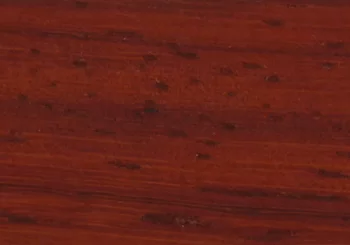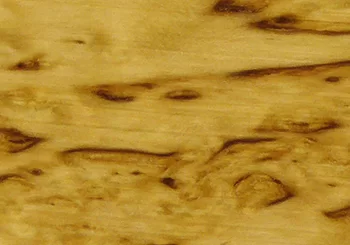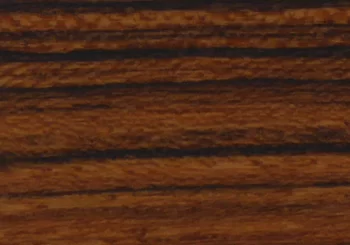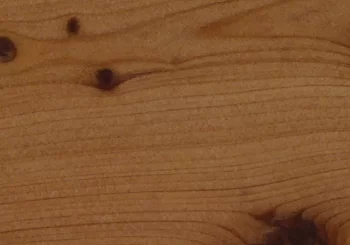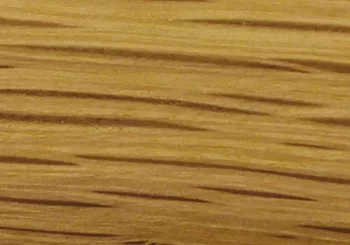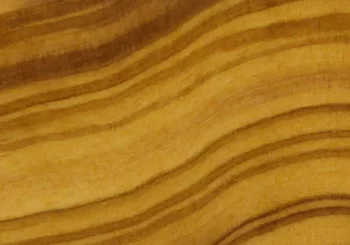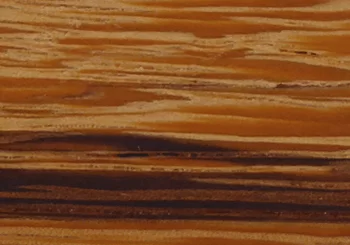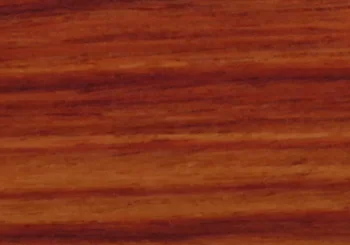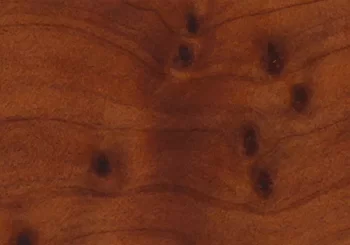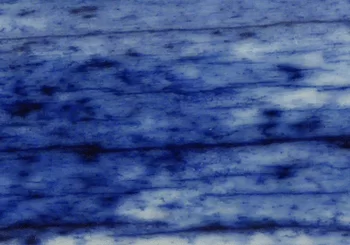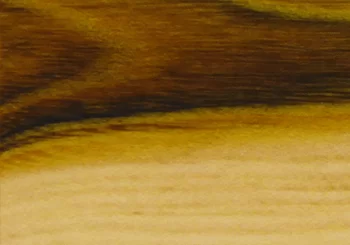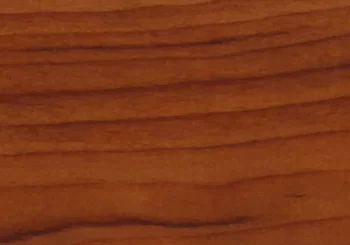AFRICAN PADAUK WOODCoral wood (Chassalia corallioides) is a species of plant in the rubiaceae family. It is endemic to the island of Reunion, a French overseas department in the southwest of the Indian Ocean. It is easily recognizable by its coral-like inflorescence. |
AMBOYNA ROOT WOODNative to Asia, from its scientific name Pterocarpus indicus, amboyna wood, also known as "dragon blood", bears the name of the island where it was discovered. Used in cutlery, marquetry and veneer, it is a precious species whose burr reveals patterns of unusual delicacy. |
AMOURETTE WOODBrosimum guianense, the amourette wood or speckled letter, is a South American tree in the Moraceae family. Its wood is very dense and can recall patterns of snakeskin. The French name of "lettre mouchetée" finds its origin in an ancient use of this wood: because of its solidity, it was used to make block letters, while the small black spots which adorn this wood earned it the adjective of amourette. It comes from Guyana and Suriname most often. It is used for musical instruments (violin bows), for knife handles and for turning precious objects like pens. The trunks are small and the sapwood is often removed during felling, which is why only small objects can be made in love. |
BIRCH WOODBirch wood from northern Europe is one of the whitest. The purity of birch is expressed naturally in more than one way: decoratively and ecologically too, since other species of birch grow quite easily in Southern Europe. |
BLOND HORN TIPHorn is a natural material that varies in nuance. These varying hues are all part of their beauty and what make each handle unique. Our handles are carved from the main horn to give incredibly robust, top quality knives. In ancient times, horn was favoured more highly than wood for its solidity. Black horn is known for its solidity, it almost certainly owes its reputation to the fact that the first horns used were those of the buffalo, a very strong, hardy animal. Horn handles can vary enormously in hue ranging from very dark (almost plain black) to dark beige. |
BOCOTE WOODNative to Mexico or Costa Rica, bocote is a precious wood. Its color varies from light brown to dark brown with gold reflections, passing through shades of green and marked with black streaks. |
BOVINE BONEBovine bone is a naturally occurring spongy material that has been used for centuries to make dice for games of chance up to hairpins in the 19th century. In Aveyron, the traction oxen, hardened by their work, had a bone of foolproof resistance ! |
BOXWOODThe common boxwood (Buxus sempervirens) is found throughout continental and Mediterranean Europe. Buxus balearica, also called “Port Mahon boxwood” is little used in horticulture. Its wood takes on a shiny appearance after polishing, which makes it a material widely used in tableware, especially for making chess pieces. |
BRIAR ROOT WOODErica arborea is an upright evergreen shrub or small tree with a typical height in the wild of some 7 m (23 ft), especially in Africa, but more typically 1–4 m (3–13 ft) in gardens. It bears dark green needle-like leaves and numerous small honey-scented bell-shaped white flowers. It is a calcifuge, preferring acid soil in an open sunny situation. |
BROWN HORNHorn is a natural material that varies in nuance. These varying hues are all part of their beauty and what make each handle unique. Our handles are carved from the main horn to give incredibly robust, top quality knives. In ancient times, horn was favoured more highly than wood for its solidity. Black horn is known for its solidity, it almost certainly owes its reputation to the fact that the first horns used were those of the buffalo, a very strong, hardy animal. Horn handles can vary enormously in hue ranging from very dark (almost plain black) to dark beige. |
COCOBOLO WOODCocobolo is a tropical hardwood of Central American trees belonging to the genus Dalbergia. Only the heartwood of cocobolo is used; it is usually orange or reddish-brown, often with darker irregular traces weaving through the wood. The heartwood changes color after being cut, and can be polished to a lustrous, glassy finish; being quite dense, sometimes having a specific gravity of over 1.0, it will sink in water. The sapwood (not often used) is a creamy yellow, with a sharp boundary between it and the heartwood. Cocobolo is yielded by two to four closely related species of the genus Dalbergia, of which the best known is Dalbergia retusa, a fair-sized tree, reported to reach 75–80 ft (23–24 m) in height and 3 ft (0.9 m) in diameter ; it probably is the species contributing most of the wood in the trade.(citation needed) Because of the high value of the timber, the trees yielding it have been heavily exploited, so they have become rare outside of national parks, reserves, and plantations. Only relatively small amounts of this prized wood reach the world market, and it is expensive. |
CURLY MAPLE WOODMoiré maple, curly maple or wavy maple on the back of the violin is a characteristic of maple, in which the growth of wood fibers is distorted into a pattern of shimmering waves. Appreciated for its beautiful appearance, it is frequently used in the manufacture of musical instruments, such as violins and bassoons, and in furniture. Another well-known use of the material is its use in guitars. |
GAIAC WOODIts Latin origin "lignum vitae" means "wood of life", Gaïac wood is indeed one of the densest among tropical woods. This very hard and heavy wood is used in various fields. It is found in the manufacture of furniture, certain parts for boats, wooden games (especially for the manufacture of "bourles", wooden discs used in a game still played in the north of France) but also in jewelry. |
IRONWOODIronwood is a common name for many woods or plants that have a reputation for hardness, or specifically a wood density that is heavier than water (approximately 1000 kg/m3, or 62 pounds per cubic foot), although usage of the name ironwood in English may or may not indicate a tree that yields such heavy wood. |
JUNIPER WOODWood reddish brown to yellow, fairly hard, with fine grain and distinct white sapwood. Juniper, also called Cade, is easily recognizable by its very pleasant spicy smell. It is rot-proof !Used in fumication, juniper wood is a powerful antiseptic: it was burned in homes during epidemics. It is used in the production of pencils, pipes and knife handles. Wanted in filming and art sculpture. |
OAK WOODOak wood until the 19th century was the main species used in Europe in shipbuilding and in the construction of wooden frames. It is today a species prized for its beauty, its hardness and its durability, in carpentry and for the manufacture of parquet floors. Oak is also essential for making barrels in which the best wines and spirits are aged, contributing to their flavor. |
OLIVE WOODThe olive tree is The Tree of the Mediterranean ! An emblem of those areas, it flourishes on hillsides where cicadas sing and on plains bathed in sunshine. With its golden hues, it is used in master crafts from wood-turning to sculpting and cabinet-making, and even in top of the range dining crafts. This wood will not suffer the years, rather it will sail through passing seasons without no other mark than its tint, which will darken over the years as if to witness the passing seasons. Its cream to yellow-brown tones contrast with the darker brown to black lines. This gives it a timelessness which means it will never go out of fashion. In short, a classic. Finally, you will love olive wood for its golden natural tones and its warm soft feel. |
SERPENT WOODSerpent wood (Marmoroxylon racemosum) is a precious wood endemic to the Guyanese forest. The handle is composed of large, deep yellow fibres, marbled with large irregular brown spots reminiscent of a snake's scales. This precious and rare wood grows exclusively in primary forests.This wood is hard and heavy. Its grains are irregularly spaced and remind the snake skin. It should not be confused with the English term of Snakewood or Letterwood called Amourette in French. |
ROSEWOODThere are not only one but several rose-woods. From "female" rosewood, perfume can be distilled. The other variety of rose-wood is regularly used in marquetry and, historically, for furniture (18th century especially) because of how magnificently it polishes up. For the anecdote: as rosewood was originally employed in marquetry to inlay flowers into bunches of flowers, it was nicknamed "tulipwood". The French name "bois de rose" is more closely inspired by its colour and its delightful sweet aromatic smell. It is a very fine-grained regular wood that polishes up beautifully and will doubtlessly charm amateurs of beautiful objects. It is also a very heavy and hard wood. The sculptor had better use well honed tools to carve it ! |
ROYAL EBONY WOODRoyal Ebony (botanical name Diospyros malabarica) is native to Southeast Asia. Also called Malabar Ebony, Indian Persimmon or Moonlight Ebony, it is a white wood with black veining. These black veins are sometimes ear-shaped, it is a hardwood that will provide a very appreciable depth of finish. |
THUJA ROOT WOODThe many magnifying root that are distributed in irregular groups in the Thuja burl give this veneer a lively appearance. Its design loaded in varieties of intense reddish-brown colors is a real eye-catcher. Because this veneer is only available in small sizes, it is often used for purposes of decorating delicate furniture parts. |
VIOLET WOODOn the call Kingwood in English which means King's wood. In the 17th century, it was reserved for nobles and aristocracy, hence its name. It belongs to the Fabaceae family and is close to rosewood species. It is used in the manufacture of veneer for furniture, marquetry, turning, inlaying and violin making.It has a purplish tint when fresh which changes to brown over time (a phenomenon due to oxidation colored tannins), and streaked with black. The grain is tight, fine and regular. The thread is straight. |
WALNUT WOODWalnut is a heterogenous wood with shades going from light brown to deep brown veined with black. Several species of walnut trees are generally used, such as European, American and Australian walnut. Often used to make furniture, it is also commonly found in cars or used to make cupboards due to its robustness. Stabilised walnut doesn't suffer the years and is therefore a favourite for the creation of sculptures and trophies. Due to its stability and solidity, it was used to make propellers in the early days of military aviation ! |
GIRAFFE BONEGiraffa cameloparlis. The Greeks believed that the giraffe resulted from the union of the camel "Camelus" and the leopard "Pardalis".The Giraffe is endemic to the African continent, from Niger to Cameroon, to South Africa.The bone plates, on the other hand, come only from carcasses found in parks and reserves in South Africa. |
MAMMOTH IVORYFossil mammoth ivory from Siberia and Mammoth molar comes with a certificate of authenticity (with an estimated age of between 7,000 and 10,000 years). It occasionally contains brown or blue-green inclusions due to the presence of iron phosphate, vivianite (blue iron earth). Collecting the rare material always involves making a field expedition. This means getting together solid teams of specialists and effective operational logistics for the Arctic environment. During the period of thaw, the prospectors dig into the permafrost close to rivers, searching for any traces of plant life that could flourish on an organic terrain. Once the zone has been marked out, they dig the ground and pull out any mammoth tusks and other fossil ivory found there. The next step is to cut the ivory up into wafer-shaped pieces that will be used to dress the knife. Occasionally, North Sea fishermen find pieces of fossil ivory in their nets that have recently been released from the sediment. This material is slightly different from that found in Siberia as the enamel is the only useable part and it is strongly colored in the middle. The thin layer of healthy material is nevertheless sufficient to make handles for folding knives. |
EBONY WOODEbony is found in tropical regions and has been known since highest Antiquity for its deep black wood. At the time of the pharaohs, ebony was already used for the manufacture of tiny precious objects of all kinds, many examples of which were found on opening the ancient tombs. Ebony belongs to the category of precious wood species. It mainly comes from Mali, but it is also found in Ghana and Togo. Due to its exceptional hardness, the diminutive size of the tree, its density and its relatively high price, objects crafted in ebony are very few and far between. Ebony is traditionally used to make piano and harpsichord keys, and sometimes even for the tuning pegs on cellos and guitars. Some splendid examples of chess sets belonging to seasoned collectors have black pieces made out of ebony and white ones made out of box. To give a gift of a Laguiole knife with an ebony handle is to give away a treasure and a slice of eternity. Ebony is a species of timeless quality and durability ! |
PISTACHIO WOODThe pistachio wood is a little tree that grows in the Garrigue and the Mediterranean maquis. A native of Syria, it produces the pistachio. Its hard wood is used in cabinetmaking and marquetry to make ornaments. The very smelly turpentine oil was originally obtained from its sap. The pistachio wood may have contrasting shades such as yellow, green and brown. |
YEW WOODTaxus baccata is a species of evergreen tree in the family Taxaceae, native to western, central and southern Europe, northwest Africa, northern Iran and southwest Asia. Wood from the yew is classified as a closed-pore softwood, similar to cedar and pine. Easy to work, yew is among the hardest of the softwoods, yet it possesses a remarkable elasticity, making it ideal for products that require springiness, such as bows.The late Robert Lundberg, a noted luthier who performed extensive research on historical lute-making methodology, states in his 2002 book Historical Lute Construction that yew was historically a prized wood for lute construction. |
DEER HORN/ANTLER... |
FOSSIL MAMMOTH MOLAR... |


